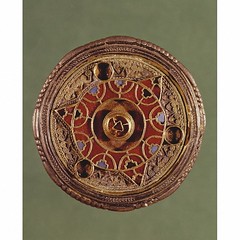By Stuart Frost
 I saw a production of Faustus in Richmond two weeks ago. The play was loosely based on the text of the Tudor playwright Christopher Marlowe. However contemporary British artists Jake and Dinos Chapman were as central to the story as Dr Faustus himself. I’ve been enjoying watching the Tudors on BBC2 on Friday evenings and I’m looking forward to watching Elizabeth: The Golden Age at the cinema at some point during the next week or two. The public’s fascination with the Tudor history has been remarkably enduring. It seems as though the public appetite for Henry VIII, Elizabeth I and Shakespeare’s work is undiminished despite an endless stream of documentaries, dramas and plays. Ray Winstone’s Henry VIII is one of my favourite recent interpretations of England’s most famous king.
I saw a production of Faustus in Richmond two weeks ago. The play was loosely based on the text of the Tudor playwright Christopher Marlowe. However contemporary British artists Jake and Dinos Chapman were as central to the story as Dr Faustus himself. I’ve been enjoying watching the Tudors on BBC2 on Friday evenings and I’m looking forward to watching Elizabeth: The Golden Age at the cinema at some point during the next week or two. The public’s fascination with the Tudor history has been remarkably enduring. It seems as though the public appetite for Henry VIII, Elizabeth I and Shakespeare’s work is undiminished despite an endless stream of documentaries, dramas and plays. Ray Winstone’s Henry VIII is one of my favourite recent interpretations of England’s most famous king.
The medieval period, by contrast, maintains a lower and more erratic public profile. Recent highpoints have included The National Theatre’s excellent production of St Joan (Joan of Arc). The Globe Theatre company also staged a fantastic production, In Extremis, which was unsual in focussing on the twelfth-century characters of Peter Abelard, Heloise and St Bernard of Clairvaux. The earlier middle ages appear to have been even more under-utilised even though it is an age as rich in drama, stories and epic struggles as any other. Perhaps the forthcoming film-version of Beowulf will encourage other filmmakers and writers to look back to the so-called Dark Ages with new enthusiasm?
 The film version of Beowulf is based on an epic Anglo-Saxon poem, a masterpiece of literature that vividly reflects the values of the culture from which it emerged. I’ve heard the poem skillfully recited in the original language which was a remarkable experience. Even though I couldn’t understand a word if felt as through the distance between the past and present had collapsed. The first part of the poem is the most well known. The young Beowulf comes to the aid of King Hrothgar whose people are terrorised by the monster Grendel. Whilst Angelina Jolie is ‘box office’ she certainly isn’t the most obvious choice to play the mother of the hideous Grendel. I hope that the film does the spirit of the poem justice.
The film version of Beowulf is based on an epic Anglo-Saxon poem, a masterpiece of literature that vividly reflects the values of the culture from which it emerged. I’ve heard the poem skillfully recited in the original language which was a remarkable experience. Even though I couldn’t understand a word if felt as through the distance between the past and present had collapsed. The first part of the poem is the most well known. The young Beowulf comes to the aid of King Hrothgar whose people are terrorised by the monster Grendel. Whilst Angelina Jolie is ‘box office’ she certainly isn’t the most obvious choice to play the mother of the hideous Grendel. I hope that the film does the spirit of the poem justice.
I‘ve illustrated this blog-entry with a selection of objects which belong to the same era as the poem. Whilst the Museum doesn’t hold many Anglo-Saxon artefacts you can see from these pieces of jewellery that what material there is is incredibly beautiful. The people who were buried with these brooches may well have been familiar with the heroic deeds of Beowulf. Hopefully after the film version has completed its run a whole new generation will also be able to recount the outline of the story, and will have been inspired to go back to the orginal text.